Tạo một File Chooser đơn giản trong Android
1. Android File Chooser?
Trong hệ điều hành Windows bạn rất quen thuộc với File Chooser, nó giúp bạn lựa chọn các tập tin có trong máy tính của bạn. Câu hỏi của bạn là có cái gì đó tương tự như vậy trong Android hay không?
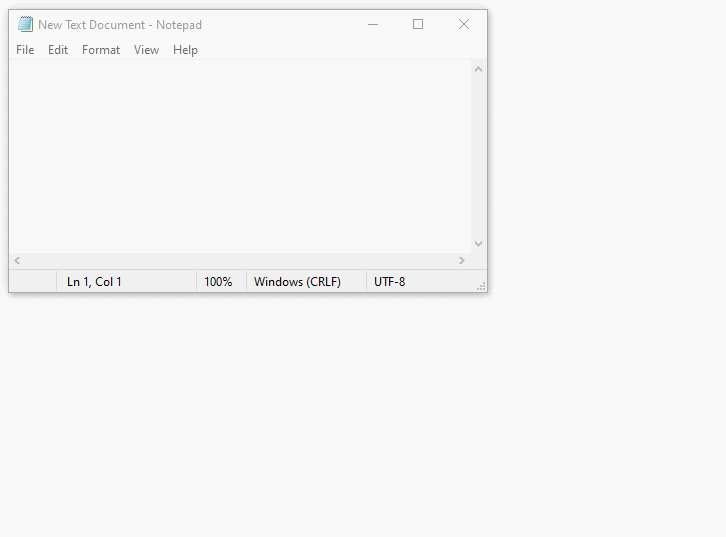
Thật đáng tiếc không sẵn có File Chooser trong Android, nhưng bạn không cần phải lo lắng, trong bài viết này tôi sẽ hướng dẫn bạn tạo ra một FileChooserFragment mô phỏng một File Chooser, và bạn có thể tái sử dụng nó trong các dự án của bạn.
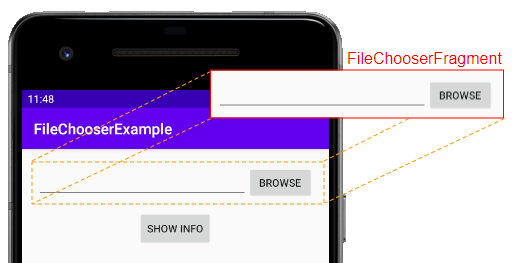
2. Ví dụ Android File Chooser
Xem trước ví dụ:
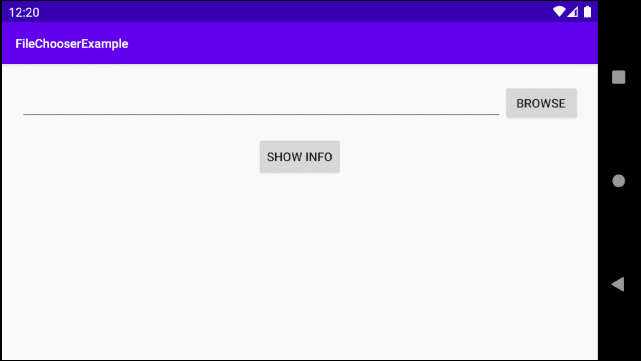
Chú ý: Bạn cần một vài tập tin để test ví dụ này trên Android Emulator. OK, trên cửa sổ Device File Explorer copy một vài tập tin vào thư mục "sdcard/Download", giống như hình minh họa dưới đây:
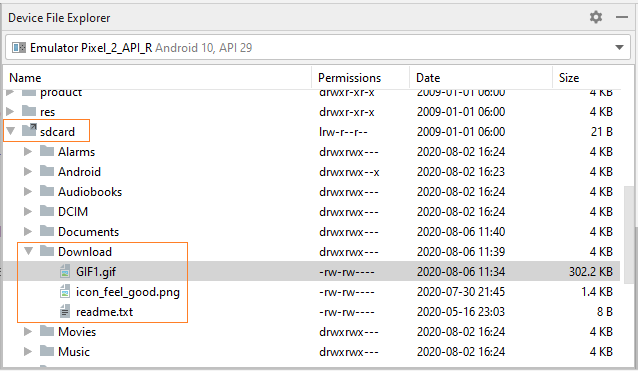
Trên Android Studio tạo mới một project:
- File > New > New Project > Empty Activity
- Name: FileChooserExample
- Package name: org.o7planning.filechooserexample
- Language: Java
Thêm đoạn code dưới đây vào AndroidManifest.xml để nói với Android rằng "Hãy cho phép ứng dụng này truy cập vào bộ nhớ ngoài của thiết bị":
<uses-permission android:name="android.permission.READ_EXTERNAL_STORAGE"/>AndroidManifest.xml
<?xml version="1.0" encoding="utf-8"?>
<manifest xmlns:android="http://schemas.android.com/apk/res/android"
package="org.o7planning.filechooserexample">
<uses-permission android:name="android.permission.READ_EXTERNAL_STORAGE"/>
<application
android:allowBackup="true"
android:icon="@mipmap/ic_launcher"
android:label="@string/app_name"
android:roundIcon="@mipmap/ic_launcher_round"
android:supportsRtl="true"
android:theme="@style/AppTheme">
<activity android:name=".MainActivity">
<intent-filter>
<action android:name="android.intent.action.MAIN" />
<category android:name="android.intent.category.LAUNCHER" />
</intent-filter>
</activity>
</application>
</manifest>Chú ý: Android 6.0+ (API Level 23+) đòi hỏi một mức bảo mật cao hơn, vì vậy ứng dụng của bạn cần phải hỏi người dùng để được phép truy cập vào bộ nhớ ngoài của thiết bị (Xem cách xử lý trong code của ví dụ).
FileChooserFragment
Tiếp theo chúng ta tạo một FileChooserFragment, bạn có thể sử dụng Fragment này tại nhiều nơi trong dự án của bạn.
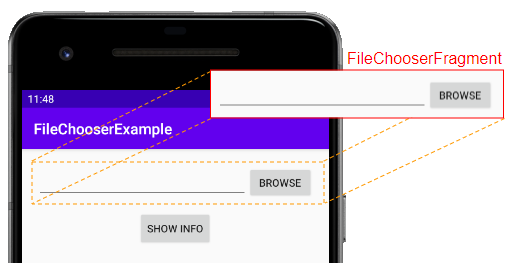
Nhấn phải chuột vào project, và chọn:
- File > New > Fragment > Fragment (Blank)
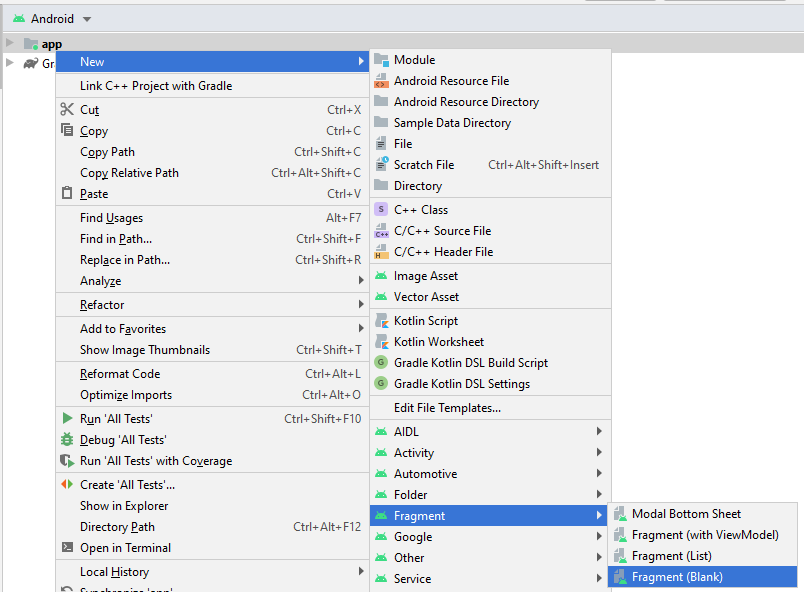
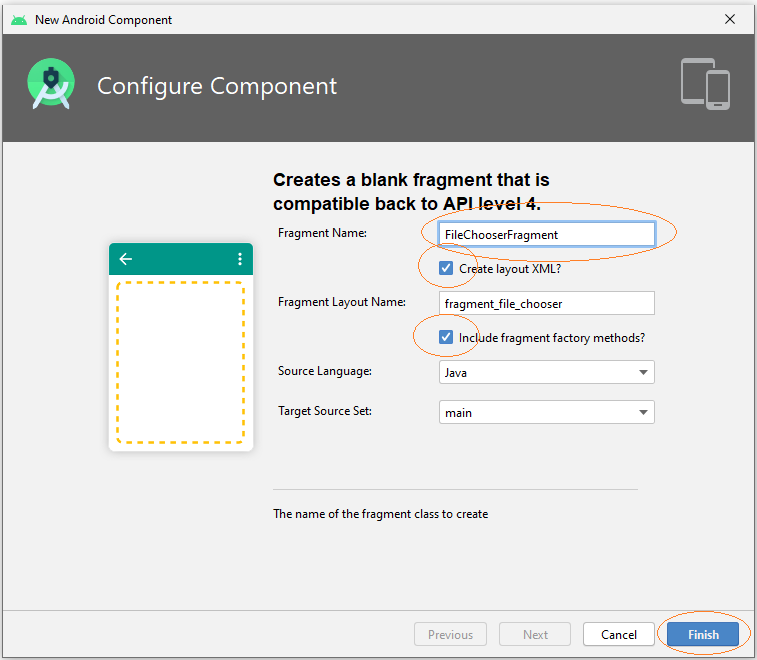
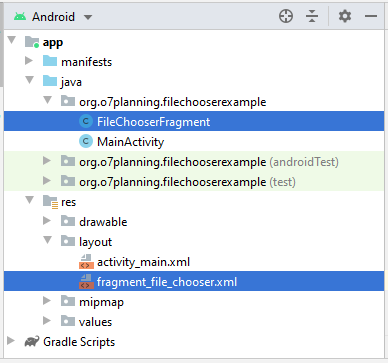
Mở tập tin fragment_file_chooser.xml để thiết kế giao diện cho FileChooserFragment.

Sét đặt ID, Text cho các thành phần trên giao diện:
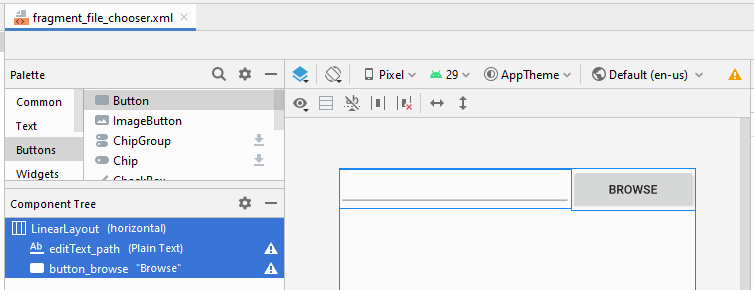
fragment_file_chooser.xml
<?xml version="1.0" encoding="utf-8"?>
<LinearLayout xmlns:android="http://schemas.android.com/apk/res/android"
xmlns:tools="http://schemas.android.com/tools"
android:layout_width="match_parent"
android:layout_height="match_parent"
android:dividerPadding="5sp"
tools:context=".FileChooserFragment">
<EditText
android:id="@+id/editText_path"
android:layout_width="wrap_content"
android:layout_height="wrap_content"
android:layout_weight="1"
android:ems="10"
android:inputType="textUri" />
<Button
android:id="@+id/button_browse"
android:layout_width="wrap_content"
android:layout_height="wrap_content"
android:layout_weight="0"
android:text="Browse" />
</LinearLayout>FileChooserFragment.java
package org.o7planning.filechooserexample;
import android.Manifest;
import android.app.Activity;
import android.content.Intent;
import android.content.pm.PackageManager;
import android.net.Uri;
import android.os.Bundle;
import androidx.core.app.ActivityCompat;
import androidx.fragment.app.Fragment;
import android.util.Log;
import android.view.LayoutInflater;
import android.view.View;
import android.view.ViewGroup;
import android.widget.Button;
import android.widget.EditText;
import android.widget.Toast;
public class FileChooserFragment extends Fragment {
private static final int MY_REQUEST_CODE_PERMISSION = 1000;
private static final int MY_RESULT_CODE_FILECHOOSER = 2000;
private Button buttonBrowse;
private EditText editTextPath;
private static final String LOG_TAG = "AndroidExample";
@Override
public View onCreateView(final LayoutInflater inflater, final ViewGroup container, final Bundle savedInstanceState) {
View rootView = inflater.inflate(R.layout.fragment_file_chooser, container, false);
this.editTextPath = (EditText) rootView.findViewById(R.id.editText_path);
this.buttonBrowse = (Button) rootView.findViewById(R.id.button_browse);
this.buttonBrowse.setOnClickListener(new View.OnClickListener() {
@Override
public void onClick(View view) {
askPermissionAndBrowseFile();
}
});
return rootView;
}
private void askPermissionAndBrowseFile() {
// With Android Level >= 23, you have to ask the user
// for permission to access External Storage.
if (android.os.Build.VERSION.SDK_INT >= android.os.Build.VERSION_CODES.M) { // Level 23
// Check if we have Call permission
int permisson = ActivityCompat.checkSelfPermission(this.getContext(),
Manifest.permission.READ_EXTERNAL_STORAGE);
if (permisson != PackageManager.PERMISSION_GRANTED) {
// If don't have permission so prompt the user.
this.requestPermissions(
new String[]{Manifest.permission.READ_EXTERNAL_STORAGE},
MY_REQUEST_CODE_PERMISSION
);
return;
}
}
this.doBrowseFile();
}
private void doBrowseFile() {
Intent chooseFileIntent = new Intent(Intent.ACTION_GET_CONTENT);
chooseFileIntent.setType("*/*");
// Only return URIs that can be opened with ContentResolver
chooseFileIntent.addCategory(Intent.CATEGORY_OPENABLE);
chooseFileIntent = Intent.createChooser(chooseFileIntent, "Choose a file");
startActivityForResult(chooseFileIntent, MY_RESULT_CODE_FILECHOOSER);
}
// When you have the request results
@Override
public void onRequestPermissionsResult(int requestCode,
String permissions[], int[] grantResults) {
super.onRequestPermissionsResult(requestCode, permissions, grantResults);
//
switch (requestCode) {
case MY_REQUEST_CODE_PERMISSION: {
// Note: If request is cancelled, the result arrays are empty.
// Permissions granted (CALL_PHONE).
if (grantResults.length > 0
&& grantResults[0] == PackageManager.PERMISSION_GRANTED) {
Log.i( LOG_TAG,"Permission granted!");
Toast.makeText(this.getContext(), "Permission granted!", Toast.LENGTH_SHORT).show();
this.doBrowseFile();
}
// Cancelled or denied.
else {
Log.i(LOG_TAG,"Permission denied!");
Toast.makeText(this.getContext(), "Permission denied!", Toast.LENGTH_SHORT).show();
}
break;
}
}
}
@Override
public void onActivityResult(int requestCode, int resultCode, Intent data) {
switch (requestCode) {
case MY_RESULT_CODE_FILECHOOSER:
if (resultCode == Activity.RESULT_OK ) {
if(data != null) {
Uri fileUri = data.getData();
Log.i(LOG_TAG, "Uri: " + fileUri);
String filePath = null;
try {
filePath = FileUtils.getPath(this.getContext(),fileUri);
} catch (Exception e) {
Log.e(LOG_TAG,"Error: " + e);
Toast.makeText(this.getContext(), "Error: " + e, Toast.LENGTH_SHORT).show();
}
this.editTextPath.setText(filePath);
}
}
break;
}
super.onActivityResult(requestCode, resultCode, data);
}
public String getPath() {
return this.editTextPath.getText().toString();
}
}Sau khi có FileChooserFragment bạn có thể sử dụng nó tại bất kỳ nơi nào trong dự án.
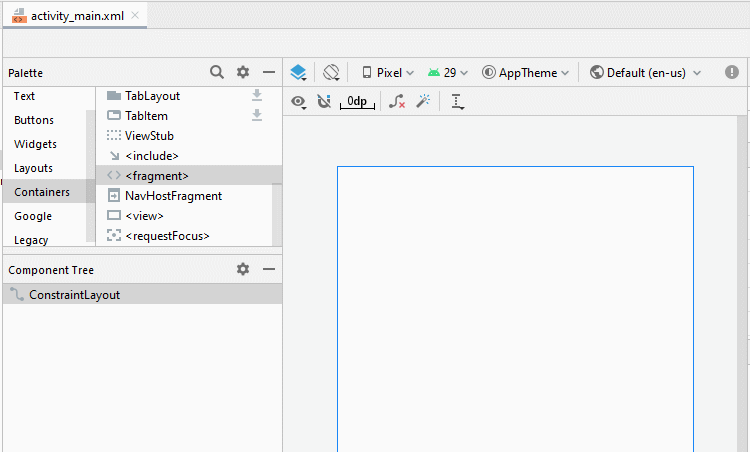
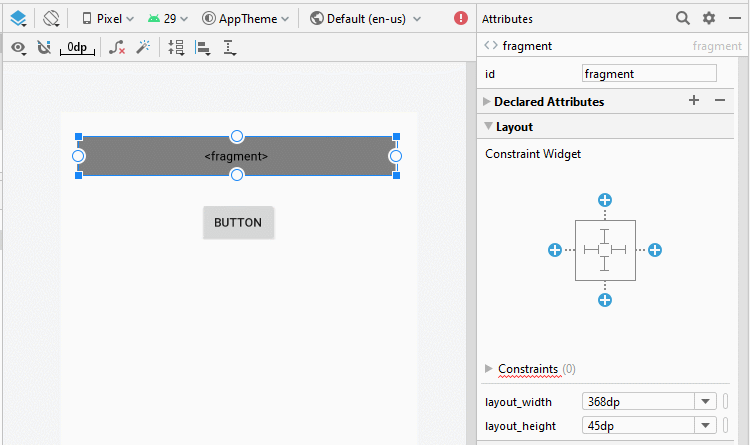
Sét đặt ID, Text cho các thành phần trên giao diện:
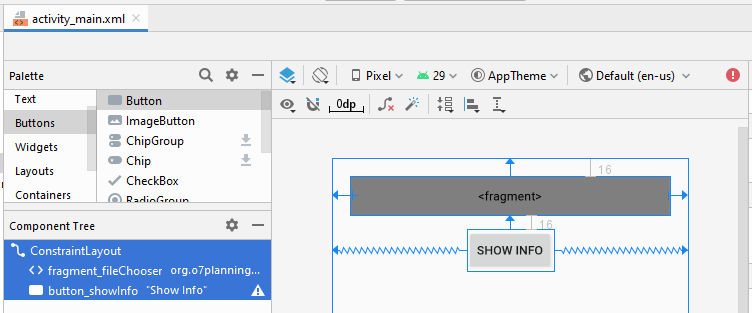
activity_main.xml
<?xml version="1.0" encoding="utf-8"?>
<androidx.constraintlayout.widget.ConstraintLayout
xmlns:android="http://schemas.android.com/apk/res/android"
xmlns:app="http://schemas.android.com/apk/res-auto"
xmlns:tools="http://schemas.android.com/tools"
android:layout_width="match_parent"
android:layout_height="match_parent"
android:paddingLeft="5sp"
android:paddingTop="5sp"
android:paddingRight="5sp"
android:paddingBottom="5sp"
tools:context=".MainActivity" >
<fragment
android:id="@+id/fragment_fileChooser"
android:name="org.o7planning.filechooserexample.FileChooserFragment"
android:layout_width="0dp"
android:layout_height="45dp"
android:layout_marginStart="16dp"
android:layout_marginLeft="16dp"
android:layout_marginTop="16dp"
android:layout_marginEnd="16dp"
android:layout_marginRight="16dp"
app:layout_constraintEnd_toEndOf="parent"
app:layout_constraintStart_toStartOf="parent"
app:layout_constraintTop_toTopOf="parent" />
<Button
android:id="@+id/button_showInfo"
android:layout_width="wrap_content"
android:layout_height="wrap_content"
android:layout_marginTop="16dp"
android:text="Show Info"
app:layout_constraintEnd_toEndOf="parent"
app:layout_constraintStart_toStartOf="parent"
app:layout_constraintTop_toBottomOf="@+id/fragment_fileChooser" />
</androidx.constraintlayout.widget.ConstraintLayout>MainActivity.java
package org.o7planning.filechooserexample;
import androidx.appcompat.app.AppCompatActivity;
import androidx.fragment.app.FragmentManager;
import android.os.Bundle;
import android.view.View;
import android.widget.Button;
import android.widget.Toast;
public class MainActivity extends AppCompatActivity {
private FileChooserFragment fragment;
private Button buttonShowInfo;
@Override
protected void onCreate(Bundle savedInstanceState) {
super.onCreate(savedInstanceState);
setContentView(R.layout.activity_main);
FragmentManager fragmentManager = this.getSupportFragmentManager();
this.fragment = (FileChooserFragment) fragmentManager.findFragmentById(R.id.fragment_fileChooser);
this.buttonShowInfo = this.findViewById(R.id.button_showInfo);
this.buttonShowInfo.setOnClickListener(new View.OnClickListener() {
@Override
public void onClick(View v) {
showInfo();
}
});
}
private void showInfo() {
String path = this.fragment.getPath();
Toast.makeText(this, "Path: " + path, Toast.LENGTH_LONG).show();
}
}FileUtils.java
package org.o7planning.filechooserexample;
import android.annotation.SuppressLint;
import android.content.ContentResolver;
import android.content.ContentUris;
import android.content.Context;
import android.database.Cursor;
import android.net.Uri;
import android.os.Build;
import android.os.Environment;
import android.provider.DocumentsContract;
import android.provider.MediaStore;
import android.provider.OpenableColumns;
import android.text.TextUtils;
import android.util.Log;
import java.io.File;
import java.io.FileOutputStream;
import java.io.InputStream;
public class FileUtils {
private static final String LOG_TAG = "FileUtils";
private static Uri contentUri = null;
/**
* Get a file path from a Uri. This will get the the path for Storage Access
* Framework Documents, as well as the _data field for the MediaStore and
* other file-based ContentProviders.<br>
* <br>
* Callers should check whether the path is local before assuming it
* represents a local file.
*
* @param context The context.
* @param uri The Uri to query.
*/
@SuppressLint("NewApi")
public static String getPath(final Context context, final Uri uri) {
// Check here to KITKAT or new version
final boolean isKitKat = Build.VERSION.SDK_INT >= Build.VERSION_CODES.KITKAT;
String selection = null;
String[] selectionArgs = null;
// DocumentProvider
if (isKitKat && DocumentsContract.isDocumentUri(context, uri)) {
// ExternalStorageProvider
if (isExternalStorageDocument(uri)) {
final String docId = DocumentsContract.getDocumentId(uri);
final String[] split = docId.split(":");
final String type = split[0];
String fullPath = getPathFromExtSD(split);
if (fullPath != "") {
return fullPath;
} else {
return null;
}
}
// DownloadsProvider
else if (isDownloadsDocument(uri)) {
if (Build.VERSION.SDK_INT >= Build.VERSION_CODES.M) {
final String id;
Cursor cursor = null;
try {
cursor = context.getContentResolver().query(uri, new String[]{MediaStore.MediaColumns.DISPLAY_NAME}, null, null, null);
if (cursor != null && cursor.moveToFirst()) {
String fileName = cursor.getString(0);
String path = Environment.getExternalStorageDirectory().toString() + "/Download/" + fileName;
if (!TextUtils.isEmpty(path)) {
return path;
}
}
} finally {
if (cursor != null) {
cursor.close();
}
}
id = DocumentsContract.getDocumentId(uri);
if (!TextUtils.isEmpty(id)) {
if (id.startsWith("raw:")) {
return id.replaceFirst("raw:", "");
}
String[] contentUriPrefixesToTry = new String[] {
"content://downloads/public_downloads",
"content://downloads/my_downloads"
};
for (String contentUriPrefix : contentUriPrefixesToTry) {
try {
final Uri contentUri = ContentUris.withAppendedId(Uri.parse(contentUriPrefix), Long.valueOf(id));
// final Uri contentUri = ContentUris.withAppendedId(
// Uri.parse("content://downloads/public_downloads"), Long.valueOf(id));
return getDataColumn(context, contentUri, null, null);
} catch (NumberFormatException e) {
// In Android 8 and Android P the id is not a number
return uri.getPath().replaceFirst("^/document/raw:", "").replaceFirst("^raw:", "");
}
}
}
} else {
final String id = DocumentsContract.getDocumentId(uri);
final boolean isOreo = Build.VERSION.SDK_INT >= Build.VERSION_CODES.O;
if (id.startsWith("raw:")) {
return id.replaceFirst("raw:", "");
}
try {
contentUri = ContentUris.withAppendedId(
Uri.parse("content://downloads/public_downloads"), Long.valueOf(id));
} catch (NumberFormatException e) {
e.printStackTrace();
}
if (contentUri != null) {
return getDataColumn(context, contentUri, null, null);
}
}
}
// MediaProvider
else if (isMediaDocument(uri)) {
final String docId = DocumentsContract.getDocumentId(uri);
final String[] split = docId.split(":");
final String type = split[0];
Uri contentUri = null;
if ("image".equals(type)) {
contentUri = MediaStore.Images.Media.EXTERNAL_CONTENT_URI;
} else if ("video".equals(type)) {
contentUri = MediaStore.Video.Media.EXTERNAL_CONTENT_URI;
} else if ("audio".equals(type)) {
contentUri = MediaStore.Audio.Media.EXTERNAL_CONTENT_URI;
}
selection = "_id=?";
selectionArgs = new String[]{split[1]};
return getDataColumn(context, contentUri, selection,
selectionArgs);
} else if (isGoogleDriveUri(uri)) {
return getDriveFilePath(uri, context);
}
}
// MediaStore (and general)
else if ("content".equalsIgnoreCase(uri.getScheme())) {
if (isGooglePhotosUri(uri)) {
return uri.getLastPathSegment();
}
if (isGoogleDriveUri(uri)) {
return getDriveFilePath(uri, context);
}
if( Build.VERSION.SDK_INT == Build.VERSION_CODES.N) {
// return getFilePathFromURI(context,uri);
return getMediaFilePathForN(uri, context);
// return getRealPathFromURI(context,uri);
} else {
return getDataColumn(context, uri, null, null);
}
}
// File
else if ("file".equalsIgnoreCase(uri.getScheme())) {
return uri.getPath();
}
return null;
}
/**
* Check if a file exists on device
*
* @param filePath The absolute file path
*/
private static boolean fileExists(String filePath) {
File file = new File(filePath);
return file.exists();
}
/**
* Get full file path from external storage
*
* @param pathData The storage type and the relative path
*/
private static String getPathFromExtSD(String[] pathData) {
final String type = pathData[0];
final String relativePath = "/" + pathData[1];
String fullPath = "";
// on my Sony devices (4.4.4 & 5.1.1), `type` is a dynamic string
// something like "71F8-2C0A", some kind of unique id per storage
// don't know any API that can get the root path of that storage based on its id.
//
// so no "primary" type, but let the check here for other devices
if ("primary".equalsIgnoreCase(type)) {
fullPath = Environment.getExternalStorageDirectory() + relativePath;
if (fileExists(fullPath)) {
return fullPath;
}
}
// Environment.isExternalStorageRemovable() is `true` for external and internal storage
// so we cannot relay on it.
//
// instead, for each possible path, check if file exists
// we'll start with secondary storage as this could be our (physically) removable sd card
fullPath = System.getenv("SECONDARY_STORAGE") + relativePath;
if (fileExists(fullPath)) {
return fullPath;
}
fullPath = System.getenv("EXTERNAL_STORAGE") + relativePath;
if (fileExists(fullPath)) {
return fullPath;
}
return fullPath;
}
private static String getDriveFilePath(Uri uri, Context context) {
Uri returnUri = uri;
ContentResolver contentResolver = context.getContentResolver();
Cursor returnCursor = contentResolver.query(returnUri, null, null, null, null);
// Get the column indexes of the data in the Cursor,
// move to the first row in the Cursor, get the data,
// and display it.
int nameIndex = returnCursor.getColumnIndex(OpenableColumns.DISPLAY_NAME);
int sizeIndex = returnCursor.getColumnIndex(OpenableColumns.SIZE);
returnCursor.moveToFirst();
String name = (returnCursor.getString(nameIndex));
String size = (Long.toString(returnCursor.getLong(sizeIndex)));
File file = new File(context.getCacheDir(), name);
try {
InputStream inputStream = context.getContentResolver().openInputStream(uri);
FileOutputStream outputStream = new FileOutputStream(file);
int read = 0;
int maxBufferSize = 1 * 1024 * 1024;
int bytesAvailable = inputStream.available();
// int bufferSize = 1024;
int bufferSize = Math.min(bytesAvailable, maxBufferSize);
final byte[] buffers = new byte[bufferSize];
while ((read = inputStream.read(buffers)) != -1) {
outputStream.write(buffers, 0, read);
}
Log.e("File Size", "Size " + file.length());
inputStream.close();
outputStream.close();
Log.e("File Path", "Path " + file.getPath());
Log.e("File Size", "Size " + file.length());
} catch (Exception e) {
Log.e(LOG_TAG, e.getMessage());
}
return file.getPath();
}
private static String getMediaFilePathForN(Uri uri, Context context) {
Uri returnUri = uri;
Cursor returnCursor = context.getContentResolver().query(returnUri, null, null, null, null);
// Get the column indexes of the data in the Cursor,
// move to the first row in the Cursor, get the data,
// and display it.
int nameIndex = returnCursor.getColumnIndex(OpenableColumns.DISPLAY_NAME);
int sizeIndex = returnCursor.getColumnIndex(OpenableColumns.SIZE);
returnCursor.moveToFirst();
String name = (returnCursor.getString(nameIndex));
String size = (Long.toString(returnCursor.getLong(sizeIndex)));
File file = new File(context.getFilesDir(), name);
try {
InputStream inputStream = context.getContentResolver().openInputStream(uri);
FileOutputStream outputStream = new FileOutputStream(file);
int read = 0;
int maxBufferSize = 1 * 1024 * 1024;
int bytesAvailable = inputStream.available();
//int bufferSize = 1024;
int bufferSize = Math.min(bytesAvailable, maxBufferSize);
final byte[] buffers = new byte[bufferSize];
while ((read = inputStream.read(buffers)) != -1) {
outputStream.write(buffers, 0, read);
}
Log.e("File Size", "Size " + file.length());
inputStream.close();
outputStream.close();
Log.e("File Path", "Path " + file.getPath());
Log.e("File Size", "Size " + file.length());
} catch (Exception e) {
Log.e(LOG_TAG, e.getMessage());
}
return file.getPath();
}
private static String getDataColumn(Context context, Uri uri,
String selection, String[] selectionArgs) {
Cursor cursor = null;
final String column = "_data";
final String[] projection = {column};
try {
cursor = context.getContentResolver().query(uri, projection,
selection, selectionArgs, null);
if (cursor != null && cursor.moveToFirst()) {
final int index = cursor.getColumnIndexOrThrow(column);
return cursor.getString(index);
}
} finally {
if (cursor != null) {
cursor.close();
}
}
return null;
}
/**
* @param uri - The Uri to check.
* @return - Whether the Uri authority is ExternalStorageProvider.
*/
private static boolean isExternalStorageDocument(Uri uri) {
return "com.android.externalstorage.documents".equals(uri.getAuthority());
}
/**
* @param uri - The Uri to check.
* @return - Whether the Uri authority is DownloadsProvider.
*/
private static boolean isDownloadsDocument(Uri uri) {
return "com.android.providers.downloads.documents".equals(uri.getAuthority());
}
/**
* @param uri - The Uri to check.
* @return - Whether the Uri authority is MediaProvider.
*/
private static boolean isMediaDocument(Uri uri) {
return "com.android.providers.media.documents".equals(uri.getAuthority());
}
/**
* @param uri - The Uri to check.
* @return - Whether the Uri authority is Google Photos.
*/
private static boolean isGooglePhotosUri(Uri uri) {
return "com.google.android.apps.photos.content".equals(uri.getAuthority());
}
/**
* @param uri The Uri to check.
* @return Whether the Uri authority is Google Drive.
*/
private static boolean isGoogleDriveUri(Uri uri) {
return "com.google.android.apps.docs.storage".equals(uri.getAuthority()) //
|| "com.google.android.apps.docs.storage.legacy".equals(uri.getAuthority());
}
}Các hướng dẫn lập trình Android
- Cấu hình Android Emulator trong Android Studio
- Hướng dẫn và ví dụ Android ToggleButton
- Tạo một File Finder Dialog đơn giản trong Android
- Hướng dẫn và ví dụ Android TimePickerDialog
- Hướng dẫn và ví dụ Android DatePickerDialog
- Bắt đầu với Android cần những gì?
- Cài đặt Android Studio trên Windows
- Cài đặt Intel® HAXM cho Android Studio
- Hướng dẫn và ví dụ Android AsyncTask
- Hướng dẫn và ví dụ Android AsyncTaskLoader
- Hướng dẫn lập trình Android cho người mới bắt đầu - Các ví dụ cơ bản
- Làm sao biết số số điện thoại của Android Emulator và thay đổi nó
- Hướng dẫn và ví dụ Android TextInputLayout
- Hướng dẫn và ví dụ Android CardView
- Hướng dẫn và ví dụ Android ViewPager2
- Lấy số điện thoại trong Android sử dụng TelephonyManager
- Hướng dẫn và ví dụ Android Phone Call
- Hướng dẫn và ví dụ Android Wifi Scanning
- Hướng dẫn lập trình Android Game 2D cho người mới bắt đầu
- Hướng dẫn và ví dụ Android DialogFragment
- Hướng dẫn và ví dụ Android CharacterPickerDialog
- Hướng dẫn lập trình Android cho người mới bắt đầu - Hello Android
- Hướng dẫn sử dụng Android Device File Explorer
- Bật tính năng USB Debugging trên thiết bị Android
- Hướng dẫn và ví dụ Android UI Layouts
- Hướng dẫn và ví dụ Android SMS
- Hướng dẫn lập trình Android với Database SQLite
- Hướng dẫn và ví dụ Google Maps Android API
- Hướng dẫn chuyển văn bản thành lời nói trong Android
- Hướng dẫn và ví dụ Android Space
- Hướng dẫn và ví dụ Android Toast
- Tạo một Android Toast tùy biến
- Hướng dẫn và ví dụ Android SnackBar
- Hướng dẫn và ví dụ Android TextView
- Hướng dẫn và ví dụ Android TextClock
- Hướng dẫn và ví dụ Android EditText
- Hướng dẫn và ví dụ Android TextWatcher
- Định dạng số thẻ tín dụng với Android TextWatcher
- Hướng dẫn và ví dụ Android Clipboard
- Tạo một File Chooser đơn giản trong Android
- Hướng dẫn và ví dụ Android AutoCompleteTextView và MultiAutoCompleteTextView
- Hướng dẫn và ví dụ Android ImageView
- Hướng dẫn và ví dụ Android ImageSwitcher
- Hướng dẫn và ví dụ Android ScrollView và HorizontalScrollView
- Hướng dẫn và ví dụ Android WebView
- Hướng dẫn và ví dụ Android SeekBar
- Hướng dẫn và ví dụ Android Dialog
- Hướng dẫn và ví dụ Android AlertDialog
- Hướng dẫn và ví dụ Android RatingBar
- Hướng dẫn và ví dụ Android ProgressBar
- Hướng dẫn và ví dụ Android Spinner
- Hướng dẫn và ví dụ Android Button
- Hướng dẫn và ví dụ Android Switch
- Hướng dẫn và ví dụ Android ImageButton
- Hướng dẫn và ví dụ Android FloatingActionButton
- Hướng dẫn và ví dụ Android CheckBox
- Hướng dẫn và ví dụ Android RadioGroup và RadioButton
- Hướng dẫn và ví dụ Android Chip và ChipGroup
- Sử dụng các tài sản ảnh và biểu tượng của Android Studio
- Thiết lập SD Card cho Android Emulator
- Ví dụ với ChipGroup và các Chip Entry
- Làm sao thêm thư viện bên ngoài vào dự án Android trong Android Studio?
- Làm sao loại bỏ các quyền đã cho phép trên ứng dụng Android
- Làm sao loại bỏ các ứng dụng ra khỏi Android Emulator?
- Hướng dẫn và ví dụ Android LinearLayout
- Hướng dẫn và ví dụ Android TableLayout
- Hướng dẫn và ví dụ Android FrameLayout
- Hướng dẫn và ví dụ Android QuickContactBadge
- Hướng dẫn và ví dụ Android StackView
- Hướng dẫn và ví dụ Android Camera
- Hướng dẫn và ví dụ Android MediaPlayer
- Hướng dẫn và ví dụ Android VideoView
- Phát hiệu ứng âm thanh trong Android với SoundPool
- Hướng dẫn lập trình mạng trong Android - Android Networking
- Hướng dẫn xử lý JSON trong Android
- Lưu trữ dữ liệu trên thiết bị với Android SharedPreferences
- Hướng dẫn lập trình Android với bộ lưu trữ trong (Internal Storage)
- Hướng dẫn lập trình Android với bộ lưu trữ ngoài (External Storage)
- Hướng dẫn sử dụng Intent trong Android
- Ví dụ về một Android Intent tường minh, gọi một Intent khác
- Ví dụ về Android Intent không tường minh, mở một URL, gửi một email
- Hướng dẫn sử dụng Service trong Android
- Hướng dẫn sử dụng thông báo trong Android - Android Notification
- Hướng dẫn và ví dụ Android DatePicker
- Hướng dẫn và ví dụ Android TimePicker
- Hướng dẫn và ví dụ Android Chronometer
- Hướng dẫn và ví dụ Android OptionMenu
- Hướng dẫn và ví dụ Android ContextMenu
- Hướng dẫn và ví dụ Android PopupMenu
- Hướng dẫn và ví dụ Android Fragment
- Hướng dẫn và ví dụ Android ListView
- Android ListView với Checkbox sử dụng ArrayAdapter
- Hướng dẫn và ví dụ Android GridView
Show More
